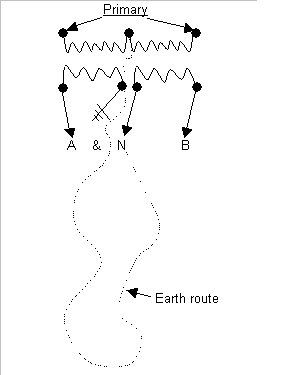Situation:
Stray neutral voltage as high as 90 volts (with a 2.7A potential) between ground/neutral bar in main house panel and the well casing (water system). The voltage increases on the neurtal when a load is applied.
Existing equipment:
200A main bkr 1ph residential panel (in residence) fed by utility co pad mount xfmr (only house on Xfmr), 100A sub feed panel in garage (seperate building). All grounding, bonding, neutral connections verified as per NEC.
Notes:
Utility Co said that there is a neutral problem, and that their equipment is ok (their equipment never fails)
All 1 phase circuits were removed from the panels and meggered out and are ok.
All heating circuits removed from panel meggered out and are ok
All other circuits (stove, water heater, well pump ckting, etc.) were removed from the panels meggered out and are ok
Disconnected sub feed cable and meggered it out and is ok
Well pump (240V) is served via a 2 wire connection from the pressure switch to the pump, no ground wire, and well casing was not grounded.
Reconnect ONLY the heating circuits (all 240 2 pole circuits) verify current is equal on both poles at branch breaker and on line side of main breaker.
As each heating circuit is turned on the voltage between the neutral bar and the well casing increases as the indavidual heating circuit is turned on.
It appears that as load is applied to the electrical service (straight 240 1ph laods only) some how the system is generating a voltage on the neutral that the transformer's neutral can not accept, and that the water system (well casing) is a better source of ground than the xfmr it self.
A ground conductor was installed from the neutral/ground bar in the main panel to the well casing and this is disapate the voltage generated as temporary fix.
The utility co. is comong back to review the problem also
I was just looking for ideas from this forum as to what could be causing this.
Thanks
Stray neutral voltage as high as 90 volts (with a 2.7A potential) between ground/neutral bar in main house panel and the well casing (water system). The voltage increases on the neurtal when a load is applied.
Existing equipment:
200A main bkr 1ph residential panel (in residence) fed by utility co pad mount xfmr (only house on Xfmr), 100A sub feed panel in garage (seperate building). All grounding, bonding, neutral connections verified as per NEC.
Notes:
Utility Co said that there is a neutral problem, and that their equipment is ok (their equipment never fails)
All 1 phase circuits were removed from the panels and meggered out and are ok.
All heating circuits removed from panel meggered out and are ok
All other circuits (stove, water heater, well pump ckting, etc.) were removed from the panels meggered out and are ok
Disconnected sub feed cable and meggered it out and is ok
Well pump (240V) is served via a 2 wire connection from the pressure switch to the pump, no ground wire, and well casing was not grounded.
Reconnect ONLY the heating circuits (all 240 2 pole circuits) verify current is equal on both poles at branch breaker and on line side of main breaker.
As each heating circuit is turned on the voltage between the neutral bar and the well casing increases as the indavidual heating circuit is turned on.
It appears that as load is applied to the electrical service (straight 240 1ph laods only) some how the system is generating a voltage on the neutral that the transformer's neutral can not accept, and that the water system (well casing) is a better source of ground than the xfmr it self.
A ground conductor was installed from the neutral/ground bar in the main panel to the well casing and this is disapate the voltage generated as temporary fix.
The utility co. is comong back to review the problem also
I was just looking for ideas from this forum as to what could be causing this.
Thanks


